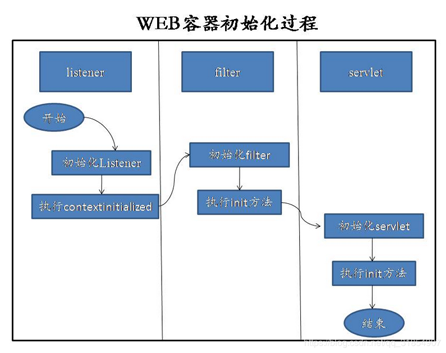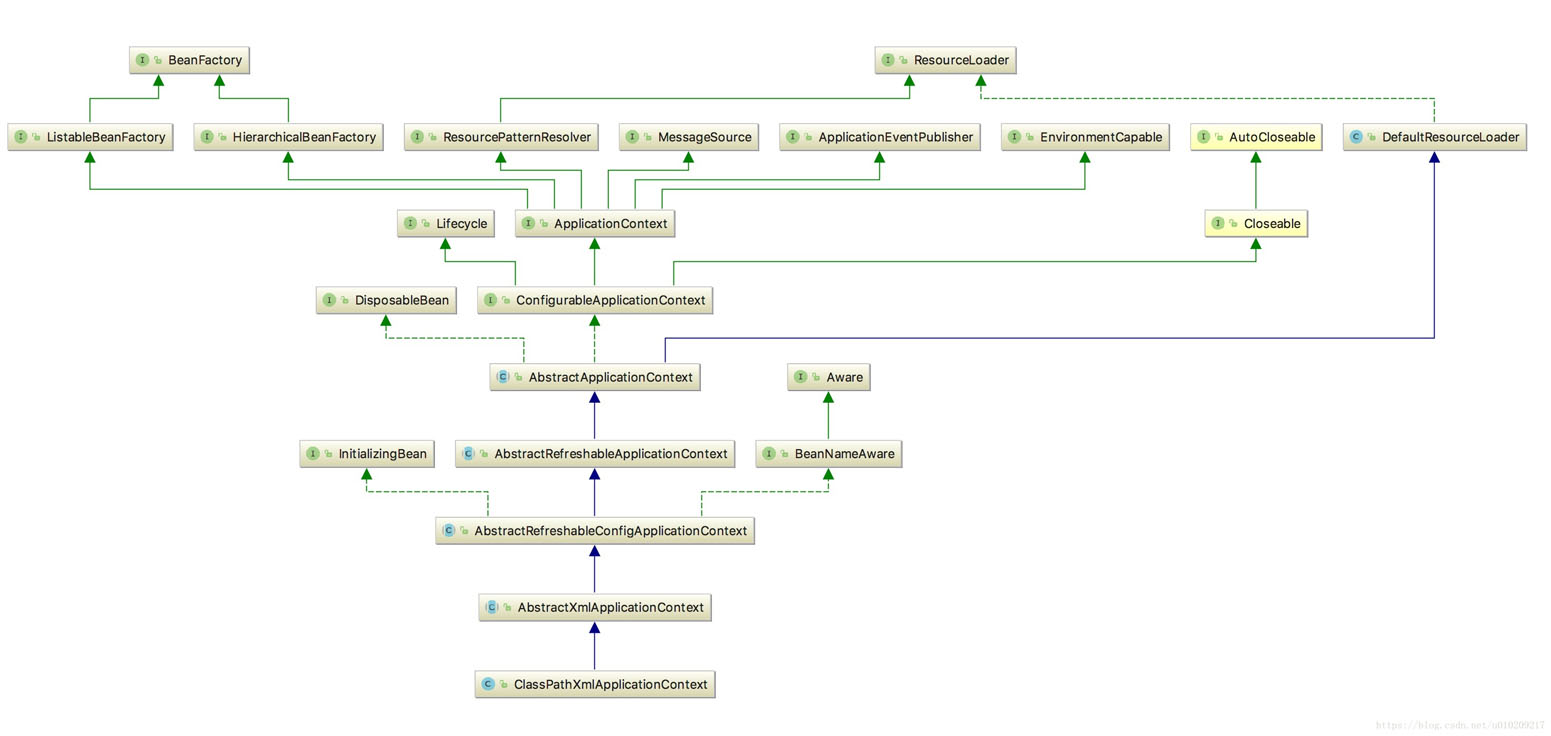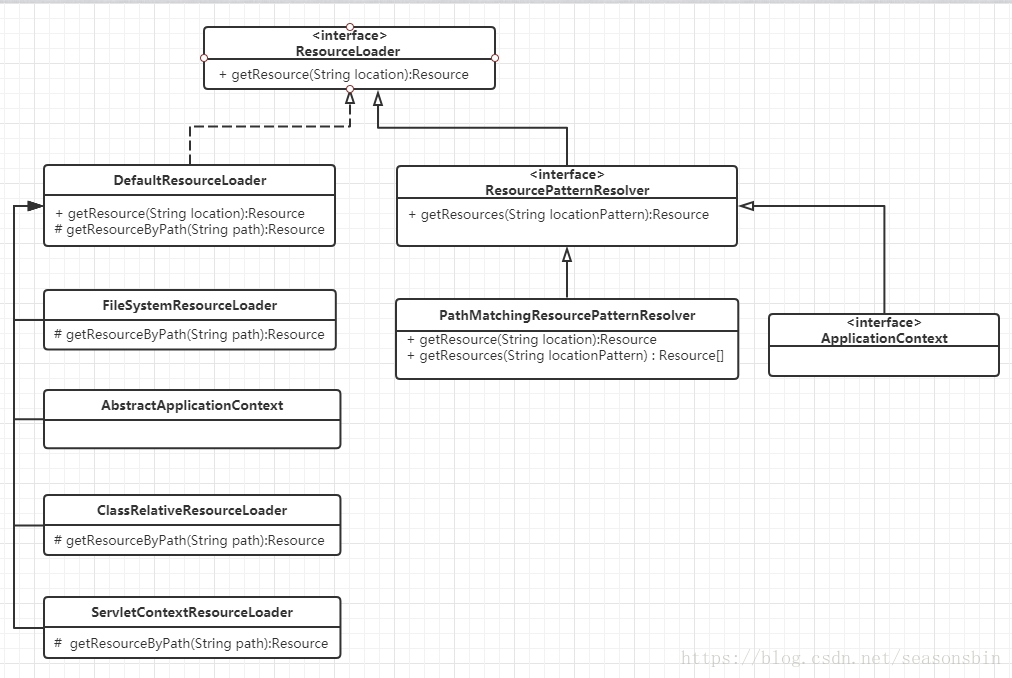您好,登錄后才能下訂單哦!
您好,登錄后才能下訂單哦!
這篇文章主要為大家展示了“如何啟動Spring項目”,內容簡而易懂,條理清晰,希望能夠幫助大家解決疑惑,下面讓小編帶領大家一起研究并學習一下“如何啟動Spring項目”這篇文章吧。
1、Spring 項目放到web項目容器中(Tomcat、Jetty、JBoss)
以通用的Tomcat為例

2、項目容器啟動時需要加載讀取web.xml配置文件
如下圖:

3、容器首先會去讀取web.xml配置文件中的兩個節點:<listener> </listener>和<context-param> </context-param>
說明:
tomcat在啟動web容器的時候會啟動一個叫ServletContextListener的監聽器,每當在web容器中有ServletContextListener這個接口被實例化的時候,web容器會通知ServletContextListener被實例的對象去執行其contextInitialized()的方法進行相應的業務處理;
而spring框架在設計的過程中ContextLoadListener這個類實現了ServletContextListener這個接口,因此每當有ContextLoadListener這個類被實例化的時候,web容器會通知Spring執行contextInitialized()這個方法,從而進行spring容器的啟動與創建的過程中;
4、ContextLoaderListener中的contextInitialized()進行了spring容器的啟動配置,調用initWebApplicationContext初始化spring容器;
@Override
public void contextInitialized(ServletContextEvent event) {
initWebApplicationContext(event.getServletContext());
}public WebApplicationContext initWebApplicationContext(ServletContext servletContext) {
//Spring 啟動的句柄,spring容器開始啟動的根目錄
if(servletContext.getAttribute(WebApplicationContext.ROOT_WEB_APPLICATION_CONTEXT_ATTRIBUTE) != null) {
throw new IllegalStateException("Cannot initialize context because there is already a root application context present - check whether you have multiple ContextLoader* definitions in your web.xml!");
} else {
Log logger = LogFactory.getLog(ContextLoader.class);
servletContext.log("Initializing Spring root WebApplicationContext");
if(logger.isInfoEnabled()) {
logger.info("Root WebApplicationContext: initialization started");
}
long startTime = System.currentTimeMillis();
try {
//處理spring容器是否已經創建(只創建沒有創建spring的各個bean)
if(this.context == null) {
this.context = this.createWebApplicationContext(servletContext);
}
if(this.context instanceof ConfigurableWebApplicationContext) {
ConfigurableWebApplicationContext cwac = (ConfigurableWebApplicationContext)this.context;
if(!cwac.isActive()) {
if(cwac.getParent() == null) {
ApplicationContext parent = this.loadParentContext(servletContext);
cwac.setParent(parent);
}
//Spring容器創建完成后,加載spring容器的各個組件
this.configureAndRefreshWebApplicationContext(cwac, servletContext);
}
}
servletContext.setAttribute(WebApplicationContext.ROOT_WEB_APPLICATION_CONTEXT_ATTRIBUTE, this.context);
ClassLoader ccl = Thread.currentThread().getContextClassLoader();
if(ccl == ContextLoader.class.getClassLoader()) {
currentContext = this.context;
} else if(ccl != null) {
currentContextPerThread.put(ccl, this.context);
}
if(logger.isDebugEnabled()) {
logger.debug("Published root WebApplicationContext as ServletContext attribute with name [" + WebApplicationContext.ROOT_WEB_APPLICATION_CONTEXT_ATTRIBUTE + "]");
}
if(logger.isInfoEnabled()) {
long elapsedTime = System.currentTimeMillis() - startTime;
logger.info("Root WebApplicationContext: initialization completed in " + elapsedTime + " ms");
}
return this.context;
} catch (RuntimeException var8) {
logger.error("Context initialization failed", var8);
servletContext.setAttribute(WebApplicationContext.ROOT_WEB_APPLICATION_CONTEXT_ATTRIBUTE, var8);
throw var8;
} catch (Error var9) {
logger.error("Context initialization failed", var9);
servletContext.setAttribute(WebApplicationContext.ROOT_WEB_APPLICATION_CONTEXT_ATTRIBUTE, var9);
throw var9;
}
}
}5、spring容器創建完成后,準備開始實例化加載bean,Spring容器創建完成后,準備向spring容器中加載bean 使用configureAndRefreshWebApplicationContext(cwac, servletContext); 完成bean的加載;
protected void configureAndRefreshWebApplicationContext(ConfigurableWebApplicationContext wac, ServletContext sc) {
if (ObjectUtils.identityToString(wac).equals(wac.getId())) {
// The application context id is still set to its original default value
// -> assign a more useful id based on available information
String idParam = sc.getInitParameter(CONTEXT_ID_PARAM);
if (idParam != null) {
wac.setId(idParam);
}
else {
// Generate default id...
wac.setId(ConfigurableWebApplicationContext.APPLICATION_CONTEXT_ID_PREFIX +
ObjectUtils.getDisplayString(sc.getContextPath()));
}
}
wac.setServletContext(sc);
String configLocationParam = sc.getInitParameter(CONFIG_LOCATION_PARAM);
if (configLocationParam != null) {
wac.setConfigLocation(configLocationParam);
}
// The wac environment's #initPropertySources will be called in any case when the context
// is refreshed; do it eagerly here to ensure servlet property sources are in place for
// use in any post-processing or initialization that occurs below prior to #refresh
ConfigurableEnvironment env = wac.getEnvironment();
if (env instanceof ConfigurableWebEnvironment) {
((ConfigurableWebEnvironment) env).initPropertySources(sc, null);
}
customizeContext(sc, wac);
wac.refresh();
}說明:
configureAndRefreshWebApplicationContext中加載spring的配置文件,即web.xml中讀取<context-param></context-param>中加載到Spring的配置文件,即:classpath:/config/applicationContext.xml;
或
通過以下代碼加載spring配置
public class Application{
public static void main(String[] args) {
ClassPathXmlApplicationContext ctx = new ClassPathXmlApplicationContext("/context.xml");
ctx.start();
}
}此處略過如何調用DefaultResourceLoader
頂級接口ResourceLoader僅提供了一個getResource(String location)方法,可以根據一個資源地址加載資源文件,資源地址的表達式可以是以下幾種:
--1. classpath:前綴開頭的表達式,例如: classpath:smart-context.xml
--2.“/”開頭的表達式,例如:/WEB-INF/classes/smart-context.xml
--3. 非“/”開頭的表達,例如:WEB-INF/classes/smart-context.xml
--4. url協議,例如:file:/D:/ALANWANG-AIA/Horse-workspace/chapter3/target/classes/smart-context.xml


Spring提供了實現類DefaultResourceLoader,DefaultResourceLoader在實現了以上列舉的功能基礎上,還為開發者提供了自定義擴展接口ProtocolResolver,開發者可實現該接口定制個性化資源表達式,代碼如下:
@Override
public Resource getResource(String location) {
Assert.notNull(location, "Location must not be null");
for (ProtocolResolver protocolResolver : this.protocolResolvers) { // 1
Resource resource = protocolResolver.resolve(location, this);
if (resource != null) {return resource;}
}
if (location.startsWith("/")) {return getResourceByPath(location);} //2
else if (location.startsWith(CLASSPATH_URL_PREFIX)) { //3
return new ClassPathResource(location.substring(CLASSPATH_URL_PREFIX.length()), getClassLoader());
}
else {
try {
// Try to parse the location as a URL...
URL url = new URL(location); //4
return new UrlResource(url);
}
catch (MalformedURLException ex) {
// No URL -> resolve as resource path.
return getResourceByPath(location); //5
}
}
}步驟1,先用擴展協議解析器解析資源地址并返回。舉個例子,咱們可以自定義資源解析器來完成帶前綴“classpath:”的解析:
首先實現ProtocolResolver接口:
class ClasspathPreProtocolResolver implements ProtocolResolver{
private static String CLASS_PATH_PRE="classpath:";
public Resource resolve(String location, ResourceLoader resourceLoader) {
if( location.startsWith(CLASS_PATH_PRE)) {
return new ClassPathResource(location.substring(CLASS_PATH_PRE.length()));
}
return null;
}
}步驟2,假設location以斜杠開頭,則調用該類中 getResourceByPath(String path)方法 ,代碼如下:
protected Resource getResourceByPath(String path) {
return new ClassPathContextResource(path, getClassLoader());
}步驟三,假如資源表達式以classpath開頭,則截取除前綴calsspath:的路徑,并做為ClassPathResource的構造參數,生成ClassPathResource實例后返回。咱們可以在web.xml中做如下配置:
<context-param> <param-name>contextConfigLocation</param-name> <param-value>classpath:/config/applicationContext.xml</param-value> </context-param>
6、通過refresh()內部的實現我們大致可以了解整個refresh()方法擔負了整個Spring容器初始化和加載的所有邏輯,包括Bean工廠的初始化、post-processor的注冊以及調用、bean的實例化、事件發布等。
以上是“如何啟動Spring項目”這篇文章的所有內容,感謝各位的閱讀!相信大家都有了一定的了解,希望分享的內容對大家有所幫助,如果還想學習更多知識,歡迎關注億速云行業資訊頻道!
免責聲明:本站發布的內容(圖片、視頻和文字)以原創、轉載和分享為主,文章觀點不代表本網站立場,如果涉及侵權請聯系站長郵箱:is@yisu.com進行舉報,并提供相關證據,一經查實,將立刻刪除涉嫌侵權內容。